What does it take to raise capital, in SaaS, in 2018?
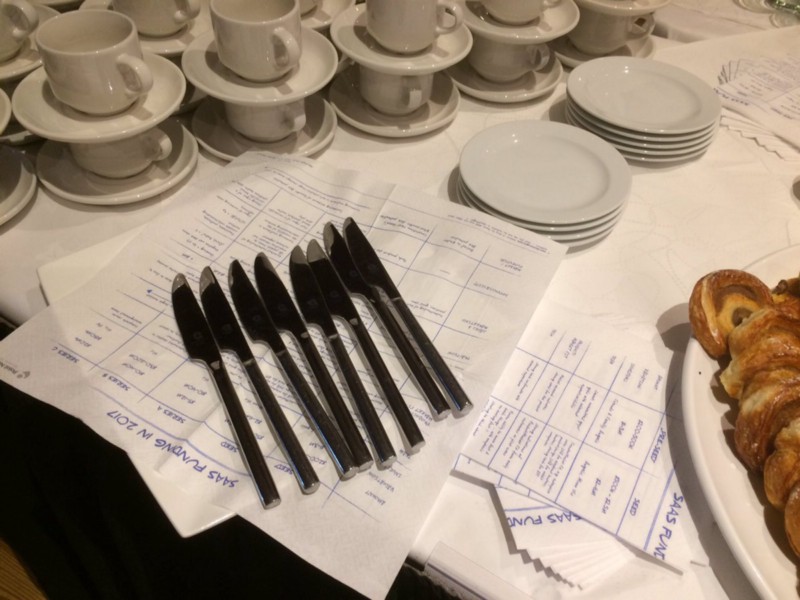
About two years ago I thought about the question of what it takes to raise capital, in SaaS, in 2016 and tried to give an answer that would fit on the proverbial back of a napkin. The result was the "SaaS Funding Napkin", a virtual one initially, followed before too long by a real napkin that made regular appearances (and friends) at SaaS conferences around the world. A year ago I created an update for 2017. Now it's time for the 2018 version.
In the previous two years, the data that I've put on the napkin was based on what we had seen in the market and anecdotal feedback from a few other investors. For this year's update, I decided to broaden the dataset by sending out a Typeform to a much larger number of SaaS investors. As a result, the data is now based on a much larger sample size and should provide a fairly accurate answer to the question asked in the headline above.
As I have quite a lot of data to present, I'll split this article into three parts. In this post, part 1, I'll start with some brief, general information about the survey and will then dig into the quantitative answers. In part 2, which will be published tomorrow, I'll turn to the free-form answers, and in part 3 you'll get the updated napkin. Ready to go?
What we wanted to know
The first question was "Which stage are you focused on?", because we wanted to ask people a different set of subsequent questions depending on whether they invest at the seed stage or at later stages.
For Series A/B/C investors, the first part of the Typeform then looked like this:
- "How much ARR - quite roughly - do you expect a SaaS company to have when it raises its Series A/B/C round?"
- "What kind of y/y ARR growth gets you excited when you're considering an investment?"
- "And what kind of y/y ARR growth do you expect in the 12 months following your investment?"
- "Optional question: What are the Top 3 things you're looking for when you assess a potential SaaS Series A/B/C investment?" (free form question)
From seed investors we wanted to know:
- "What are the things you are looking for in a SaaS seed round?" The answer options were "founders with a proven track record", "strong technical co-founder", "Product/Market Fit", "paying customers" and "revenue", and we asked people to rate each option on a scale from one to five, one being "not important at all", five being "extremely important".
- If the investor rated "revenue" with three or more points, we asked how much ARR, quite roughly, they expect a SaaS company to have when they are considering a seed investment.
- "What else are you looking for when you assess a potential SaaS seed investment?" (free form question)
After that we asked all investors a couple of additional, optional questions:
- How many SaaS investments did your firm make in 2017?
- Optional question: How many SaaS investments do you think your firm will make in 2018?
- Optional question: Quite roughly, what was the average pre-money valuation of the SaaS seed/A/B/C deals that your firm did in 2017?
- Optional question: Quite roughly, what was the average round size of the SaaS seed/A/B/C deals that your firm did in 2017?
These questions were the same for seed and Series A/B/C investors, but where you see "seed/A/B/C" above, the wording was customized based on the answer we received at the beginning of the survey. Fortunately, these customizations and "logic jumps" are super easy to set up with Typeform!
Here's the Typeform that we sent out, in case you'd like to take a look.
The data
In total, we got responses from more than 60 VCs, including many of the industry's most active and most respected SaaS investors in Europe (Accel, Acton, Alven, Connect Ventures, Creandum, Dawn, DN Capital, EQT, eVentures, Idinvest, Index, Localglobe, MMC, Mosaic, Notion, Northzone, Partech, Runa, Sunstone) and the US (Access, Battery, Benchmark, Bessemer, Canaan, CRV, Emergence, Floodgate, General Catalyst, GGV, Homebrew, IA, Icon, Iconiq, Insight, KPCB, Matrix, Meritech, NVP, OpenView, Redpoint, Salesforce Ventures, Sapphire, Scale, Shasta, SignalFire, SV Angel, Uncork, Upfront, Valar). A big thank-you to everyone who took the time to participate!
In statistical terms, 60 is not a large sample size. However, since we're talking about the constituents of a small, highly competitive and extremely well-connected market, I'm quite confident that the results are pretty representative for the market at large. We didn't get enough data points from Series C investors, though, and have therefore not included Series C data in the results.
But enough about the background of the survey, let's take a look at the results!
ARR and growth expectations of Series A/B/C investors
1. How much ARR - quite roughly - do you expect a SaaS company to have when it raises its Series A/B/C round?
Most Series A investors expect a little over $1M in ARR, while most Series B investors are looking for around $5M in ARR:

Note that there are a few outliers: Two Series A VCs said they expect $3M and another one said $2.5M, which is significantly more than what at least one of the Series B investors expect.
2. What kind of y/y ARR growth gets you excited when you're considering an investment?
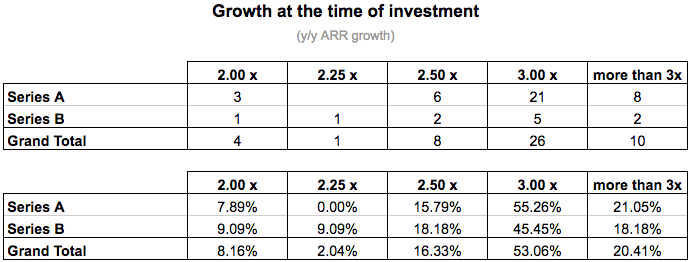
As you can see in the table above, growth expectations are as high as they've ever been:
- The vast majority of Series A and even Series B investors doesn't get excited unless you're growing at 3x or even more.
- Not a single investor mentioned a number below 2x.
That doesn't mean that none of these investors will ever invest into a company with a slower growth rate. It does mean, though, that if you're growing less fast, there need to be other, extremely compelling reasons to invest. It also means that lots and lots of SaaS startups will struggle to raise their next round of financing - a topic my colleagues and I covered extensively on this blog. (Check out, for example, Clément's post about "The Rise of 'non VC compatible' SaaS Companies".)
3. And what kind of y/y ARR growth do you expect in the 12 months following your investment?
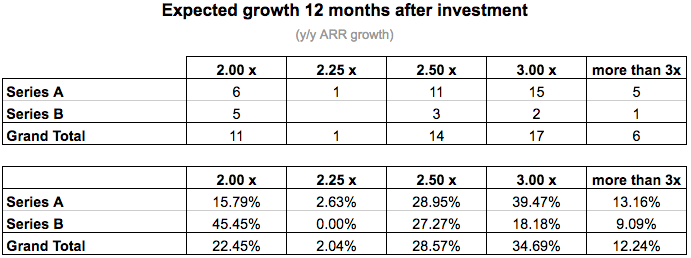
As you can see, growth expectations for the 12 months after the investment are a little lower compared to the 12 months leading to the investment, which of course makes sense, as it's hard to keep growing at the same rate when you reach larger scale. Here's a chart that visualizes the change in growth expectations pre vs. post investment:
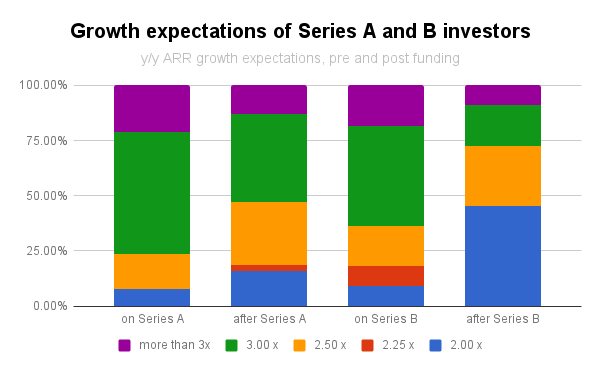
As you can see, the decline is stronger at the Series B than at the Series A stage. At the time of the investment, most Series B investors expect a SaaS company to grow 3x more. For the 12 months after the investment, most of them are happy with 2-2.5x. Keep in mind, though, that this is based on eleven Series B respondents only, so the data set for this subset is quite small.
Here's another way to look at the data:
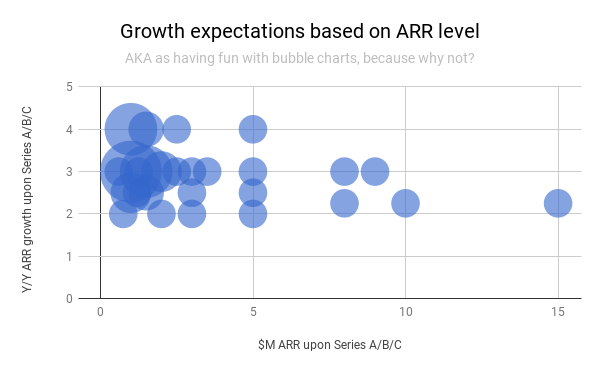
In this chart, each bubble represents an intersection on the s̶p̶a̶c̶e̶/̶t̶i̶m̶e̶ ARR/growth continuum. A larger bubble means that the ARR/growth pair has been mentioned multiple times. As mentioned above, the data set is very small for later-stage investors, but with a little bit of goodwill you can a spot a trend towards lower growth rates and smaller variance for later stages:
source: Medium